
Porcupines are the largest African rodents, weighing up to 27kg. Although they are common in Kruger, they are rarely seen because of their nocturnal habits. By day they hide in their burrows and emerge after dusk to forage, sometimes wandering up to 15km, seeking a variety of foods, including roots, bulbs, bark and wild fruit.
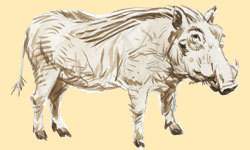 Warthog (Phacochoerus aethiopicus)
Warthog (Phacochoerus aethiopicus)
Characteristics
Pig-like animal with extended snout and tusks; grey skin with a bristly manei; males weigh up to 150kg and stand 80cm high; approximately 3800 in Kruger.
Food
Grazer and rooter of bulbs; usually found in small families of two sows and their piglets; average herd size in Kruger is two to five; males are usually solitary; loves mud baths; little fat on body so hates cold weather.
Where best to see them in Kruger
Grazer; open savanna, particularly around water holes and marshy areas, common throughout Kruger.
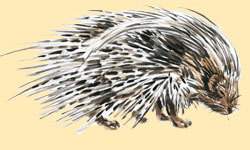 South African Porcupine (Hystrix africaeaustralis)
South African Porcupine (Hystrix africaeaustralis)
Characteristics
Largest African rodent; body covered with thick, sharp black-and-white quills, nocturnal animal that sleeps by day often in communal burrows; it does not shoot out quills but charges backwards at aggressors, trying to spike them.
Food
Vegetarian diet of bulbs, tubers, tree bark, roots, berries; known to gnaw on bones.
Where best to see them in Kruger
Occur in a variety of habitats throughout Kruger, but generally where the landscape is broken and hilly.
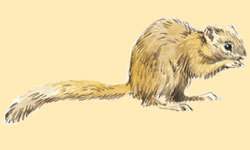 Tree squirrel (Paraxerus cepapi)
Tree squirrel (Paraxerus cepapi)
Characteristics
Distinctly bushy tails, active during the day, either singly, in pairs or in groups; active in trees and on the ground.
Food
Nuts, fruit, roots, grass, birds' eggs and sometimes insects.
Where best to see them in Kruger
Woodland savanna throughout Kruger; particularly prevalent in mopaneveld.
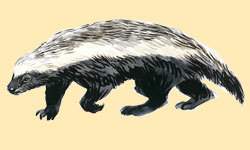 Honey badger OR Ratel (Mellivora capensis)
Honey badger OR Ratel (Mellivora capensis)
Characteristics
Distinctive white strip down head and back; shy, nocturnal animals but aggressive when cornered; bear-like claws that are good for digging; thick fur and tough, elastic skin is main defence, especially against bees.
Food
Ruthless love of honey and can withstand attacks by swarms of bees; also feeds on small mammals, reptiles, insects, bulbs, roots and fruit.
Where best to see them in Kruger
Found in all Kruger habitats, from savanna grassland to dense woodland.
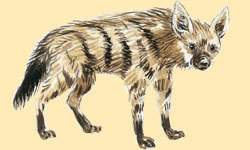 Aardwolf (Proteles cristatus)
Aardwolf (Proteles cristatus)
Characteristics
Hyaena-like nocturnal animal that sleeps by day in burrows; morphologically they appear to be a link between civets and mongooses.
Food
Small teeth and narrow jaws limit its diet to insects; feeds mostly on termites but does eat plant material and birds' eggs.
Where best to see them in Kruger
Uncommon in Kruger; limited to Pretoriuskop area and the Lebombo flats in the east.
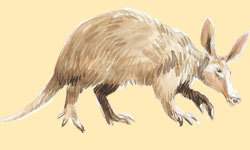 Aardvark (Orycteropus afer)
Aardvark (Orycteropus afer)
Characteristics
Pig-sized, hairy animal with long snout; walks long distances at night in search of food and sleeps in burrows during the day; tongue is 30cm long.
Food
Termites, ants, insect larvae, certain plants.
Where best to see them in Kruger
Open savanna grassland, particularly where there are lots of termite mounds and anthills.
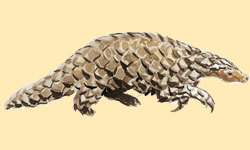 Pangolin OR Scaly antbear (Manis temminckii)
Pangolin OR Scaly antbear (Manis temminckii)
Characteristics
Dinosuar-like scaly body; nocturnal, generally solitary animal about one metre long; small eyes, no visible ears and long, sticky tongue; rolls up into a ball when challenged.
Food
Primarily ants and termites which it digs out of the ground.
Where best to see them in Kruger
Lightly wooded savanna grassland where there are lots of termite mounds
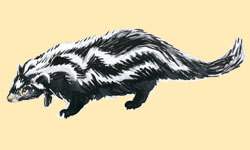 Striped polecat (Ictonyx striatus)
Striped polecat (Ictonyx striatus)
Characteristics
Nocturnal animals with distinctive white stripes from the nape of the neck to the tail.
Food
Rodents, hares, snakes, frogs, birds and insects.
Where best to see them in Kruger
Open savanna, drier areas in eastern Kruger.
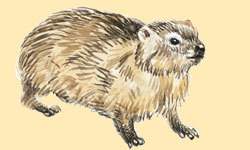 Rock dassie or cape hyrax (Procavia capensis)
Rock dassie or cape hyrax (Procavia capensis)
Characteristics
Gregarious creatures that live in colonies of up to 50 animals, prominent on rocks where they lie in the sun for hours.
Food
Vegetarian diet of grass, leaves, fruit, bark and twigs.
Where best to see them in Kruger
Confined to the more mountainous areas of Kruger - the south-western foothills, the Lebombo and the northern sandveld.
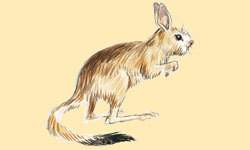 Spring hare (Pedetes capensis)
Spring hare (Pedetes capensis)
Characteristics
Very powerful hindlegs with short front legs; distinctive ears; mostly nocturnal; lives in communal burrows.
Food
Grass, roots, tubers, bulbs.
Where best to see them in Kruger
Confined mostly to the northern sandveld.
Illustration: Chip Snaddon

